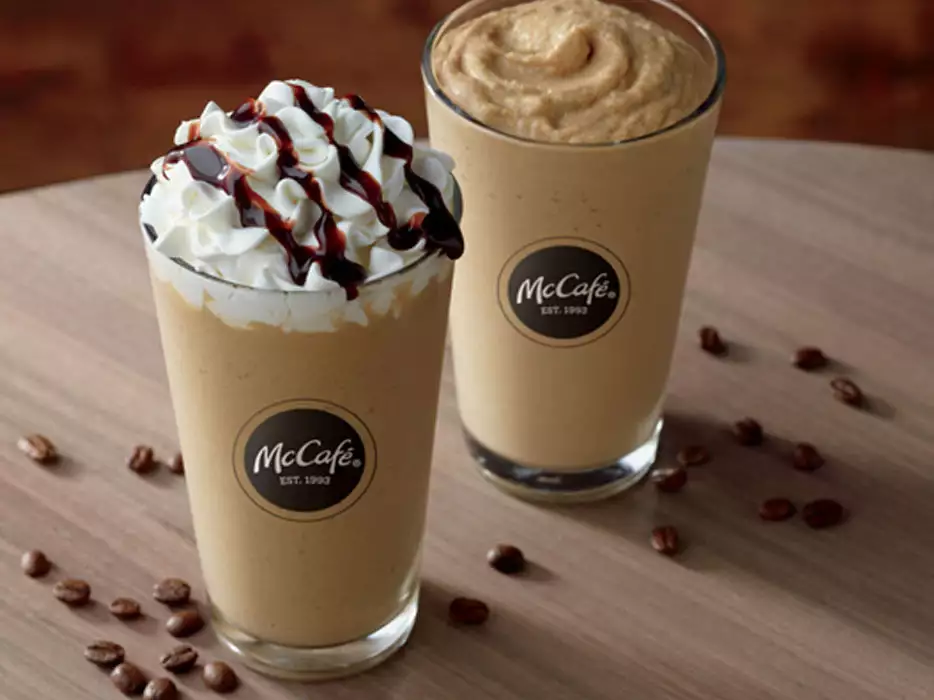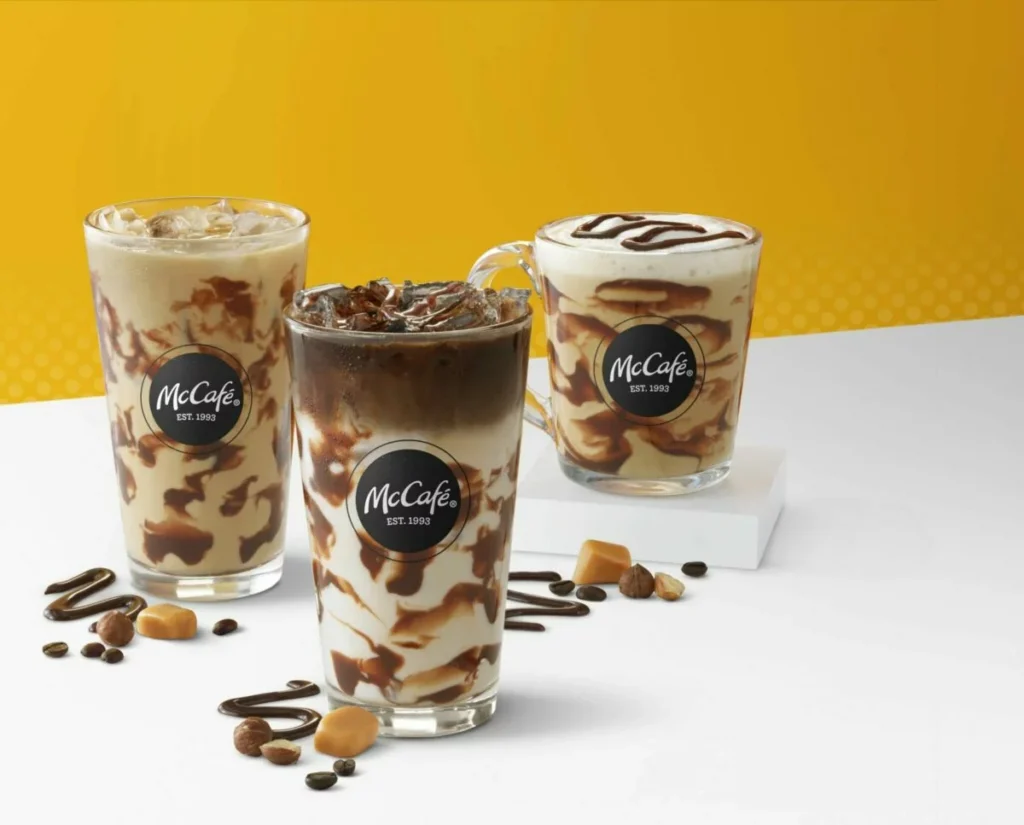Are you a coffee lover who can’t start their day without a refreshing iced coffee? If so, then you’ve probably wondered about the caffeine content in your favorite McDonald’s iced coffee. In this article, we will dive into the exact amount of caffeine you can expect to find in McDonald’s iced coffee. But that’s not all – we’ll also explore the other ingredients that make up this delicious beverage and even provide a guide on how you can make your own McDonald’s inspired iced coffee at home. So, grab your cup and get ready to discover the caffeine secrets of McDonald’s iced coffee.
Delving Deeper into the Caffeine Content of McDonald’s Iced Coffee

mcdonalds iced coffee
McDonald’s, a global fast-food chain renowned for its burgers, has also carved a niche for itself in the beverage industry. Among its vast array of drinks, the iced coffee stands out for its refreshing taste and invigorating caffeine kick. This chilled delight, nestled between the robust Americano and the indulgent Caramel Latte on the menu, has won the hearts of both coffee aficionados and occasional drinkers. But what’s the secret behind this energy boost? It’s all about the caffeine content.
McDonald’s iced coffee offers a flexible caffeine experience, depending on the size of the serving. The caffeine content of this popular beverage ranges from a moderate 120 milligrams in a 12-fluid ounce cup to an impressive 320 milligrams in a 32-fluid ounce serving. This size-dependent caffeine content allows customers to tailor their caffeine intake according to their needs or preferences, a thoughtful detail that McDonald’s has incorporated to enhance customer satisfaction.
Indeed, the caffeine in McDonald’s iced coffee can serve as a reliable energy source, especially for those who need a quick pick-me-up. However, it’s essential to remember that caffeine, while a natural stimulant found in beverages like coffee, tea, and cocoa, should be consumed responsibly. Despite its potential benefits, such as providing an energy boost and improving focus, excessive consumption could lead to unwanted side effects. These may include headaches, restlessness, and even insomnia.
So, whether you’re a student pulling an all-nighter, a busy professional needing a mid-afternoon energy boost, or simply a coffee enthusiast who enjoys the refreshing taste of iced coffee, understanding the caffeine content can help you make informed choices. The next time you order a McDonald’s iced coffee, remember that the power to control your caffeine intake lies in your hands – or rather, in the size of your cup.
So go ahead, enjoy your iced coffee, but remember to drink responsibly. After all, it’s not just about the caffeine rush, but also the enjoyment of savoring a well-crafted beverage.
Unraveling the Symphony of Ingredients in McDonald’s Iced Coffee

mcdonalds coffee
McDonald’s iced coffee is much more than just a caffeinated drink. It’s a symphony of flavors, each ingredient playing a crucial role in creating the final melody that dances on your taste buds. The caffeine content might be the star of the show, but there are several other supporting actors that contribute to the overall experience.
Let’s start with sugar. This sweet substance is the backbone of any good iced coffee, giving it that delightful sweetness that contrasts beautifully with the bitterness of the coffee. McDonald’s uses just the right amount to create a balanced flavor profile, ensuring that the sweetness doesn’t overpower the other ingredients. It’s worth noting that the sugar content can vary depending on the size and flavor of the iced coffee, so those watching their sugar intake should keep this in mind.
Next up is cream. This velvety ingredient adds a layer of richness and texture to the iced coffee, making each sip a luxurious experience. The cream also helps to mellow out the strong coffee flavor, creating a harmonious blend that is both refreshing and satisfying. Some flavors may contain additional cream, leading to a higher calorie content. It’s always a good idea to check the nutritional information if you’re counting calories.
Lastly, McDonald’s offers a variety of flavorings, from classic vanilla to indulgent caramel. These flavorings are expertly blended into the coffee, infusing each sip with a burst of flavor that elevates the entire experience. Whether you prefer the smooth, creamy notes of vanilla or the rich, buttery taste of caramel, there’s a flavor to suit every palate. Remember, though, that these flavorings can add extra calories to your drink, so choose wisely if you’re watching your waistline.
In conclusion, McDonald’s iced coffee is a complex blend of ingredients, each one carefully selected to create a beverage that is not only energizing but also delightfully tasty. So the next time you’re sipping on your iced coffee, take a moment to appreciate the symphony of flavors that make up this popular beverage.
Remember, however, that while McDonald’s iced coffee is a delicious treat, it’s important to consume it responsibly. Moderation is key, especially when it comes to caffeine and sugar intake. By making informed choices, you can enjoy your iced coffee without compromising your health.
Delving Deeper into Making McDonald’s Iced Coffee at Home

mcdonalds coffee
For those who cherish the delightful taste of McDonald’s iced coffee but yearn for an at-home, personalized experience, creating a homemade version can be a rewarding and economical alternative. This DIY approach provides you with the freedom to customize your iced coffee to your preference, ensuring that every sip is tailored to your taste buds.
Firstly, gather your ingredients. You will need ice cubes, cold milk, freshly brewed coffee, and optional sugar or flavored syrups. It’s recommended to use regular-strength coffee, but if you’re sensitive to caffeine or prefer a less potent drink, decaf is a suitable substitute.
Begin by brewing your chosen coffee. Allow it to cool to room temperature to avoid melting the ice prematurely, which could dilute the robust coffee flavor. Once cooled, fill a glass or cup with ice cubes and pour the coffee over them. This creates a refreshing cold drink, perfect for hot summer days or when you need a cool pick-me-up.
Next, pour in cold milk to achieve your desired strength. If you prefer a creamy, rich drink, opt for whole milk. For a lighter, less calorific version, skimmed or semi-skimmed milk will suffice. Dairy-free alternatives like almond, soy, or oat milk can also be used for those with dietary restrictions or preferences.
The final step is to sweeten and flavor your drink. Sugar or flavored syrups can be added to your liking, but remember to stir until fully dissolved. Popular flavors include vanilla, caramel, and hazelnut, but don’t be afraid to experiment with other options to find your perfect match.
This homemade method not only saves money but also allows you to maintain control over your caffeine and caloric intake. It provides the convenience of enjoying your favorite McDonald’s iced coffee from the comfort of your home, tailored to your specific taste and dietary needs.
However, it’s essential to remember that moderation is key. While it’s tempting to indulge in this delicious beverage, be mindful of your caffeine and sugar consumption to ensure a balanced diet. Enjoy your homemade McDonald’s iced coffee responsibly, savoring each sip while maintaining a healthy lifestyle.
Comparing McDonald’s Iced Coffee to Other Coffees
As we journey further into the realm of iced coffees, it’s essential to take a comparative analysis of McDonald’s iced coffee with other popular to-go options in the market. This comparison aims to offer a clear understanding of the caffeine content in various brands and how they stack up against each other.
Let’s start with Starbucks, a name synonymous with coffee worldwide. A small serving of Starbucks Nitro Cold Brew comes packed with 115mg of caffeine. This cold brew is a favorite among coffee enthusiasts for its velvety texture and subtly sweet flavor, but how does it fare in terms of caffeine content? It seems to fall short when compared to a small McDonald’s iced coffee, which delivers a robust 120mg of caffeine.
Moving on to another popular coffee chain, Dunkin’ Donuts, a large serving of their iced coffee contains 190mg of caffeine. While it does offer a higher caffeine content compared to a small Starbucks serving, it pales in comparison to a large McDonald’s iced coffee, which boasts a whopping 320mg of caffeine.
From this data, it’s clear that McDonald’s iced coffee is designed to not only match but also outperform some of its major competitors in terms of caffeine content. This strategy has potentially been adopted to cater to a demographic that seeks both flavor and a substantial energy boost in their coffee.
The caffeine in McDonald’s iced coffee plays a pivotal role in reducing fatigue and sharpening focus. It’s the perfect companion for those early mornings, long drives, or when you’re burning the midnight oil. However, while the prospect of a large serving of iced coffee may seem tempting, it’s important to exercise caution with dosage. Remember, too much of a good thing can turn sour, and caffeine is no exception. Balance is key.
So, next time you’re in need of a pick-me-up, you know where to find a delicious, caffeine-packed iced coffee. But don’t forget to enjoy it responsibly!
Striking the Perfect Balance with McDonald’s Iced Coffee
McDonald’s iced coffee has captured the hearts of many with its rich, full-bodied flavor and energizing caffeine kick. However, as with any beverage, it’s crucial to strike a balance between enjoyment and mindful consumption. This balance is particularly important when it comes to the caffeine content in your iced coffee.
McDonald’s offers its iced coffee in various sizes, each with a different caffeine content. The smallest size, a 12-ounce cup, contains 120 milligrams of caffeine. This is an ideal choice for those who prefer a lighter caffeine kick or are sensitive to its effects. On the other hand, if you’re looking for a more potent energy boost, you might opt for the largest size, which packs a hefty 320 milligrams of caffeine. This size is perfect for those long days when you need an extra push to get through. If you like this post also check out how many calories does McDonalds fries and cheeseburger have.
While this range of options caters to everyone’s needs and preferences, it’s important to remember that caffeine consumption should always be done in moderation. Excessive caffeine intake can lead to side effects like restlessness, insomnia, and rapid heart rate. Therefore, it’s essential to keep track of the caffeine content in your iced coffee, especially if you’re a regular consumer.
Remember, the beauty of McDonald’s iced coffee lies not only in its delicious flavor and refreshing chill, but also in its adaptability. You have the freedom to choose the size that best suits your caffeine needs and taste preferences. So, enjoy this classic beverage, but do so with a mindful eye on your caffeine intake. After all, the key to a healthy and enjoyable iced coffee experience lies in balance. If you like this post check out similar posts on our blog and learn when does McDonalds serve lunch so you can enjoy your favorite meal and have coffee afterwards.
So, whether you’re a seasoned coffee connoisseur or a casual drinker, McDonald’s iced coffee offers a delightful blend of taste, energy, and flexibility. Just remember to keep an eye on your caffeine intake, and you’re all set for a balanced and enjoyable iced coffee experience.
FAQ & Users Questions
How much caffeine is in McDonald’s Iced Coffee?
The caffeine content in McDonald’s Iced Coffee varies depending on the size of the drink. A small cup (12 fluid ounces) contains 120 mg of caffeine, while a large cup (32 fluid ounces) contains 320 mg.
What flavors does McDonald’s Iced Coffee come in?
McDonald’s offers different flavors of iced coffee, such as French Vanilla and Caramel. These flavors are made with a syrup blended into the coffee.
Can I add extra caffeine to McDonald’s Iced Coffee?
Yes, you can add extra caffeine to McDonald’s Iced Coffee by adding espresso shots. Each espresso shot contains 75 mg of caffeine.
How can I make my own version of McDonald’s Iced Coffee at home?
To make your own version of McDonald’s Iced Coffee at home, you need to brew regular strength coffee, let it cool, and pour it into an ice cube tray to make coffee cubes. You can then use these coffee cubes to make your own iced coffee by filling a cup with them and pouring regular strength coffee over top. You can add cream and/or sugar to taste.
Is it safe to consume caffeine in moderation?
Yes, consuming caffeine in moderation is generally considered safe. However, it’s important to be mindful of your caffeine intake and potential reactions. It is recommended to consult a doctor before consuming caffeine if you have any health-related concerns.
